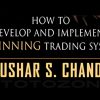Developing & Implementing Pattern-Based Trading Systems with Tushar S.Chande
$6.00
File Size: 64.1 MB
Delivery Time: 1–12 hours
Media Type: Online Course
Content Proof: Watch Here!
You may check content proof of “Developing & Implementing Pattern-Based Trading Systems with Tushar S.Chande” below:

Developing & Implementing Pattern-Based Trading Systems with Tushar S. Chande
Navigating the volatile world of trading can be overwhelming, but with the right systems in place, it becomes a calculated and manageable process. Tushar S. Chande, a seasoned trader and analyst, has mastered the art of pattern-based trading systems. These systems leverage historical data to predict future market movements, offering traders an edge. Let’s explore how you can develop and implement these systems to enhance your trading efficiency.
1. Understanding Pattern-Based Trading
What is Pattern-Based Trading?
Pattern-based trading involves identifying specific patterns within market price movements to forecast future changes. This approach is rooted in technical analysis and requires a keen eye for detail.
- Common patterns: Head and shoulders, flags, and triangles
- Prediction accuracy: Highly dependent on market conditions
Why Choose Pattern-Based Trading?
This method offers systematic decision-making, reducing emotional trading errors and improving consistency in returns.
2. The Role of Technical Analysis
Foundation of Pattern-Based Systems
Technical analysis is essential for recognizing and interpreting market patterns. Tushar S. Chande emphasizes its importance in developing effective trading strategies.
- Key tools: Candlestick charts, RSI, MACD
- Learning curve: Steep but rewarding
3. Developing Your Trading System
Step-by-Step Guide
Building a pattern-based trading system involves several critical steps:
- Identify potential patterns that have shown reliability.
- Backtest these patterns using historical data.
- Develop trading rules that are clear and actionable.
- Automate the system to execute trades based on these rules.
Choosing the Right Software
Selecting appropriate trading software is crucial for implementing these systems efficiently.
- Popular choices: MetaTrader, NinjaTrader
- Features to look for: Real-time data, backtesting capabilities, automation features
4. Implementing Your System
Integration into Daily Trading
Once developed, integrating your system into daily trading involves:
- Trial runs: Test the system with small trades.
- Adjustments: Refine the system based on performance.
- Monitoring: Keep an eye on system operations and market changes.
Risk Management
Effective risk management strategies are crucial to protect against significant losses.
- Stop-loss orders: Essential for limiting potential losses
- Position sizing: Manage exposure to any single trade
5. Advanced Techniques and Adaptations
Enhancing Your System
As markets evolve, your trading system must adapt. Incorporating machine learning and artificial intelligence can further enhance pattern recognition and predictive accuracy.
Continuous Learning
Stay updated with the latest trading technologies and methodologies to keep your system current and effective.
6. The Role of Discipline in Trading
Systematic Trading Benefits
A disciplined approach to trading using a well-defined system helps in maintaining consistency and managing psychological stress.
7. Case Studies and Success Stories
Real-World Examples
Discussing several case studies where pattern-based trading systems have led to significant trading success, illustrating the effectiveness of these approaches.
Conclusion
Developing and implementing a pattern-based trading system with guidance from experts like Tushar S. Chande can transform your trading approach from haphazard to strategic. By understanding the core principles, developing the right system, and implementing it with discipline, you can achieve greater predictability and success in the trading world. Are you ready to take your trading to the next level with these innovative strategies?
FAQs
- What is the first step in developing a pattern-based trading system?
- The first step is learning to identify reliable trading patterns within the market.
- How important is software in trading systems?
- Crucial, as it facilitates real-time data processing, backtesting, and automation of trades.
- Can these systems eliminate trading risks?
- No system can eliminate risks entirely, but pattern-based systems help in managing and mitigating them effectively.
- How often should I update my trading system?
- Regularly review and update your system to align with changing market conditions and technological advancements.
- Are there any resources to help beginners in pattern-based trading?
- Many online courses, books, and seminars are available that focus on technical analysis and pattern-based trading strategies.
Be the first to review “Developing & Implementing Pattern-Based Trading Systems with Tushar S.Chande” Cancel reply
You must be logged in to post a review.
Related products
Forex Trading
Forex Trading
Forex Trading
The Complete Guide to Multiple Time Frame Analysis & Reading Price Action with Aiman Almansoori
Forex Trading
Quantamentals – The Next Great Forefront Of Trading and Investing with Trading Markets
Forex Trading
Forex Trading
Forex Trading
























Reviews
There are no reviews yet.